The Galapagos Islands are a unique and extraordinary destination which most people visit as a trip of a lifetime. It probably comes as no surprise that Galapagos holidays are extortionate and beyond many peoples budgets. However, you can make considerable savings, (think thousands of dollars) by booking a Galapagos land-based itinerary yourself online.
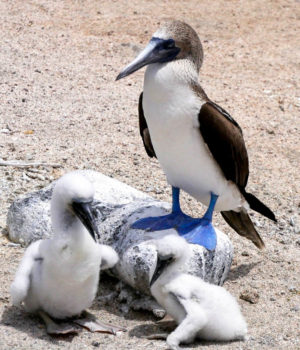
This article may contain compensated links. Please read my disclaimer policy for more info.
Where are the Galapagos Islands?
Approximate 605 miles (1000 km) to the west of northern South America an archipelago of 19 islands called the Galapagos.
Out in the middle of the ocean volcanic activity, thousands of years ago created one of the greatest wonders of the world which is home to some of the most magnificent wildlife on the planet.
The islands are part of the Republic of Ecuador, and the national language is Spanish.
Why visit Galapagos?
The diversity and unique animals of the Galapagos islands are the main reason for traveling to the Galapagos. For wildlife enthusiasts, they offer the chance to follow in the footsteps of Charles Darwin.
For everyone, the Galapagos Islands provide the opportunity to see some of the worlds most rare animals.
To preserve this rare ecosystem, the number of visitors is limited; hence why Galapagos islands travel is expensive.
When is the best time to visit Galapagos Islands?
The most popular time to visit is during the warm season, and the hottest month is March. However, the Galapagos islands weather remains a similar temperature throughout the year.
Still, there are two distinct seasons in the Galapagos archipelago. From January to May is the warm and wet season while June to December is the cool, dry season.
Divers prefer the cool season which is also the time when many of the birds come to breed.
The waved albatross, one of the worlds rarest birds visits Espagnola island in the colder months. Hence, if you are a bird watcher, July/ August is the best time to visit Galapagos.
How to plan Galapagos land-based itinerary
The most common way to experience the islands is on a Galapagos cruise. However, these cost thousands of dollars, and facilities onboard are often simple.
A more affordable and the cheapest way to see Galapagos islands is to take a land-based tour.
You can book Galapagos land-based tours with an operator however, you’ll save significant amounts by planing a DIY Galapagos itinerary.
This guide will help you do just that!
While it’s no secret that the Galapagos is expensive there are still free things to do on all the islands if you wish to keep costs down.
However, you will need to pay for some excursions on your land-based trip as certain areas of the Galapagos are prohibited without a national park guide.
There are three main inhabited islands that you can stay on in the Galapagos and a fourth which has limited accommodation.
Each island has a variety of unique Galapagos animals and several excursions to take. From the main islands, there are plenty of land tours to enjoy, and you can plan day trips to nearby Galapagos national park areas.
The best Galapagos islands holidays include all three of the main islands. However, Santa Cruz is possibly the top choice if you want to save on the budget when you visit Galapagos.
Booking Galapagos Travel
To preserve the precious ecosystems of the Galapagos and protect the wildlife, the government limit the number of visitors to the islands.
It’s therefore essential to plan your Galapagos islands, Ecuador vacation well in advance.
Book Flights and accommodation at least 12 months before departure.
Book all major day tours at least 6 months in advance. Most tours take less than 20 passengers so places soon get taken.
How to get to Galapagos Islands
There are two airports in Galapagos Islands one on Aeropuerto Galapagos San Cristobal and the other on Santa Cruz. Flights to the Galapagos islands regularly go from Quito and Guayaquil in Ecuador.
Check Skyscanner to get the best deals on flights to Ecuador and the Galapagos from your country.
The most popular Galapagos airport is Seymour Airport on Baltra Island. To make the most of your Galapagos trip, consider flying in and out of the different airports.
Quito to Galapagos flights
Flights depart daily each morning from Quito and stop at Guayaquil on the route. From Quito to Guayaquil takes approximately 30 minutes and it’s a further two-hour flight from Guayaquil to airports in Galapagos islands Ecuador.
There are more flights to Baltra Galapagos airport than San Cristobal, but each has at least one trip daily.
Whether you fly from Quito or Guayaquil to Galapagos you will need to arrive in Ecuador at least one day prior to departure.
Isabella Airport
Isabella is the third airport on Galapagos islands although it only operates light aircraft transfers between the islands. Hence you cannot fly directly here from Ecuador.
Emetebe is the airline that operates flights to and from the airport. They are also the airline that provides medical evacuation throughout the Galapagos Islands. Still, hopefully, you won’t be needing one of those.
However, if you are taking any Galapagos islands vacation, you should make sure that your medical insurance does include air ambulance. While there are medical facilities on the islands, these are basic, and any major trauma or operation would require a transfer back to the mainland.
World Nomads Insurance
World Nomads is a world leader in travel insurance and the company that I personally use for any travel abroad. Their medical insurance is excellent which means you can enjoy your holiday to the Galapagos Islands. Get a quote below today.
Departure from Ecuador to Galapagos Islands
On arrival at either Quito or Guayaquil airport, you need to head to the Galapagos deportation section.
There is a fee of 20 US dollars, for which you receive an immigration control card which you need to keep until you depart the islands. Your bags are then scanned and searched before being tagged to prevent them from being opened.
Entrance fee to Galapagos Islands
On arrival in the Galapagos, immigration is easy. However, you have to pay the National Park Fee of $100 US before collecting your bags.
Galapagos Island Hopping
The cheapest way of getting around the three main islands is by speed boat. However, it’s worth taking at least one flight with Emetebe. While it may be considerably more expensive, it’s much quicker, and the scenic views from the aircraft are stunning.
Galapagos Land-Based Itinerary 10 Days
To help plan your Galapagos islands trip I’ve put together this ten-day land-based itinerary. It includes where to stay on the Galapagos islands and suggested Galapagos islands land-based tours.
Day one – Am arrival in San Cristobal
Fly from Quito to San Cristobal in the morning. Paying the National Park fee was easy at San Cristobal Galapagos islands airport as its a small airport.
Once the sniffer dogs had checked our bags, they were put through a scanner one final time, and we were able to collect them.
It’s easy to walk from San Cristobal airport into town (Puerto Baquerizo Moreno), but most hotels will organise transfer if you prefer.
San Cristobal Galapagos hotels
There are hotels to suit all budgets on San Cristobal, but I’d highly recommend the Sunset Hotel or Casa Playa Mann.
Sunset Hotel – Luxury budget
The rooms all have an ensuite bathroom, and free wifi is available throughout the property. The location opposite the pier is excellent, and there are plenty of restaurants within easy walking distance.
The view of the sea is stunning, and there’s plenty of taxis if you want to explore the island. The hotel can arrange a transfer from the airport, although it’s only a 15-minute walk.
Click here to check out the price for your travel dates
Casa Playa Mann
A little further from the centre but closer to the beach is Casa playa Mann. The property has a beautiful garden and excellent views. The rooms are clean and comfortable with free wifi.
Each room has tea and coffee making facilities, and there’s a delicious breakfast served each morning. The staff are super friendly and will arrange airport transfers for a small fee.
For more information and pictures, click here.
Day 1 Afternoon
The Interpretation Centre
The entrance price is free.
The interpretation centre has exciting and informative displays about the history of the Galapagos. There’s also a small section on Charles Darwin and how the islands gave him the idea of evolution.
The centre focuses more on the human history and conservation of the archipelago rather than Galapagos wildlife. There are a couple of walks that are worth exploring as the views from the lookouts provide some great photo opportunities.
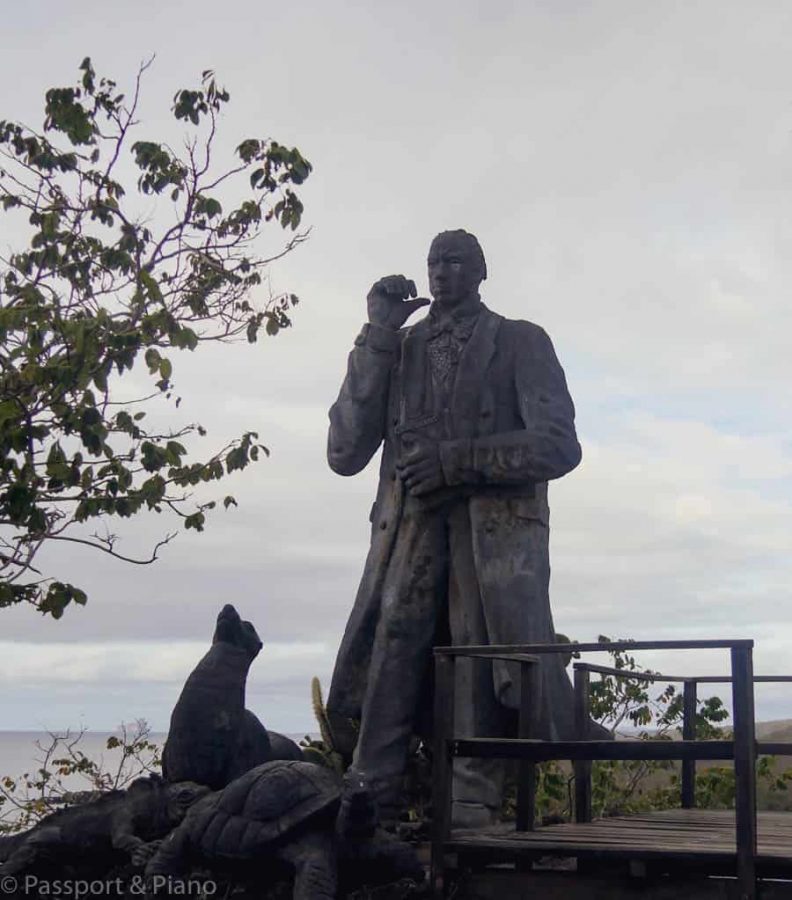
You can see Kicker rock in the distance and get close to the frigate birds which nest on Tijeretas ( frigate hill). There is also a statue of Charles Darwin, and a little wooden jetty was people snorkelling.
Walk back along the beach.
We walked back along the beach where there were lots of sea lions sunbathing and lots of sea lion poo which the guide books forget to mention. The smell isn’t great, and I wouldn’t fancy sunbathing here, but it is pretty, and you can get close to the sea lions.
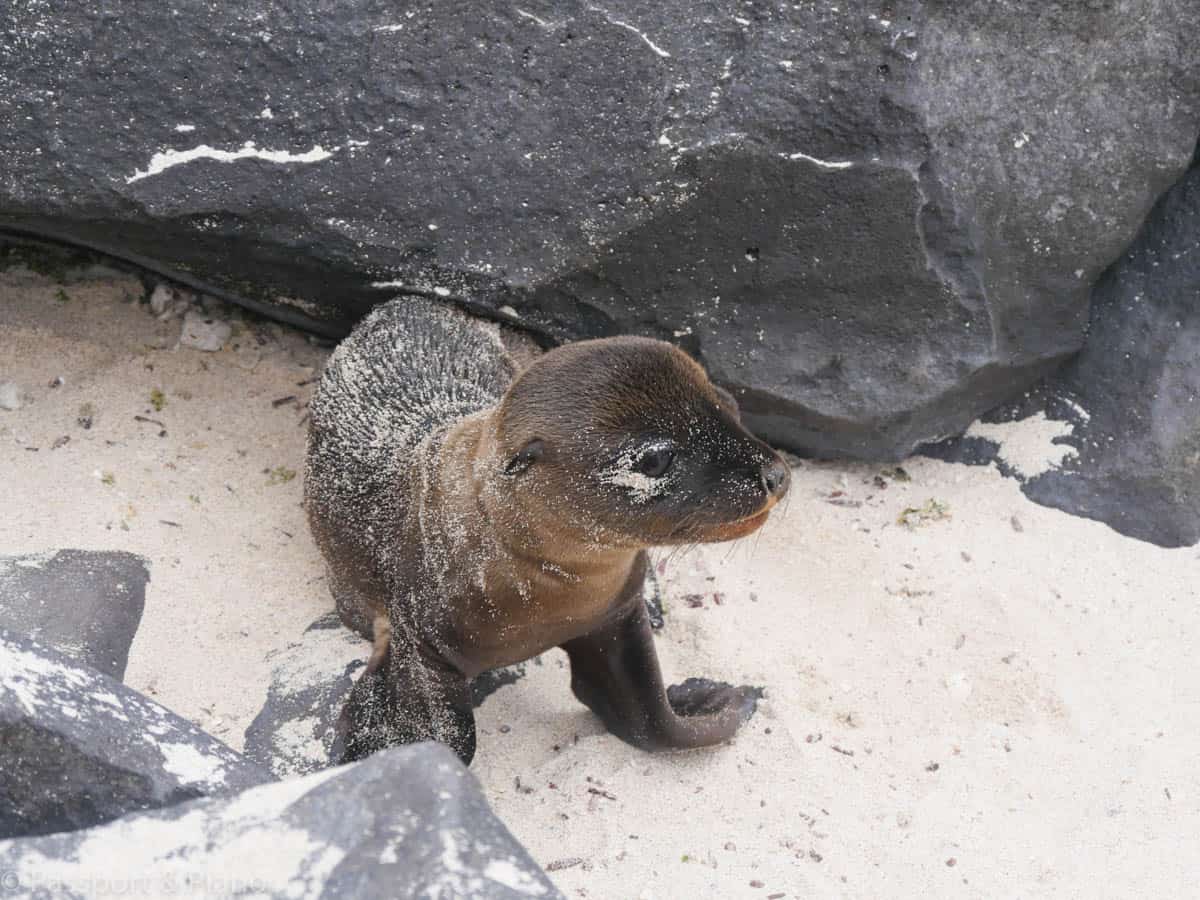
Cerro Tijeretas and Baquerizo Beach
If you want to take a longer walk, there is a trail which leads to Cerro Tijeretas from the interpretation. If you continue along the path after approximately one hour, you’ll reach Baquerizo Beach.
The beach is a great place to do some snorkelling, and there’s a good chance of seeing sea turtles, rays and sea lions. At sunset, you can also watch a variety of Galapagos birds swooping down over the ocean ask they catch their supper.
Day Two
Galapaguera and El Junco Lagoon
You can either hire some bikes or a taxi to take you to Glapaguera. If you are hiring bikes, be forewarned that it is slightly hilly and to cycle there and back will require a high level of fitness.
However, it’s easy to get a taxi truck to take to Galapaguera with the bikes and then enjoy a leisurely ride back.
La Galapaguera
La Galapaguera is a tortoise reserve whose primary focus is conservation. The Galapagos giant tortoise has been under threat for some time with some of the species already extinct.
There have been considerable conservation efforts since the 1970s. Although many thousands have been successfully released back into the wild, the species is still vulnerable.
A volunteer guide will show you around the tortoise reserve, and the tour takes approximately one hour. The guides are knowledgeable and share informative and exciting about the research.
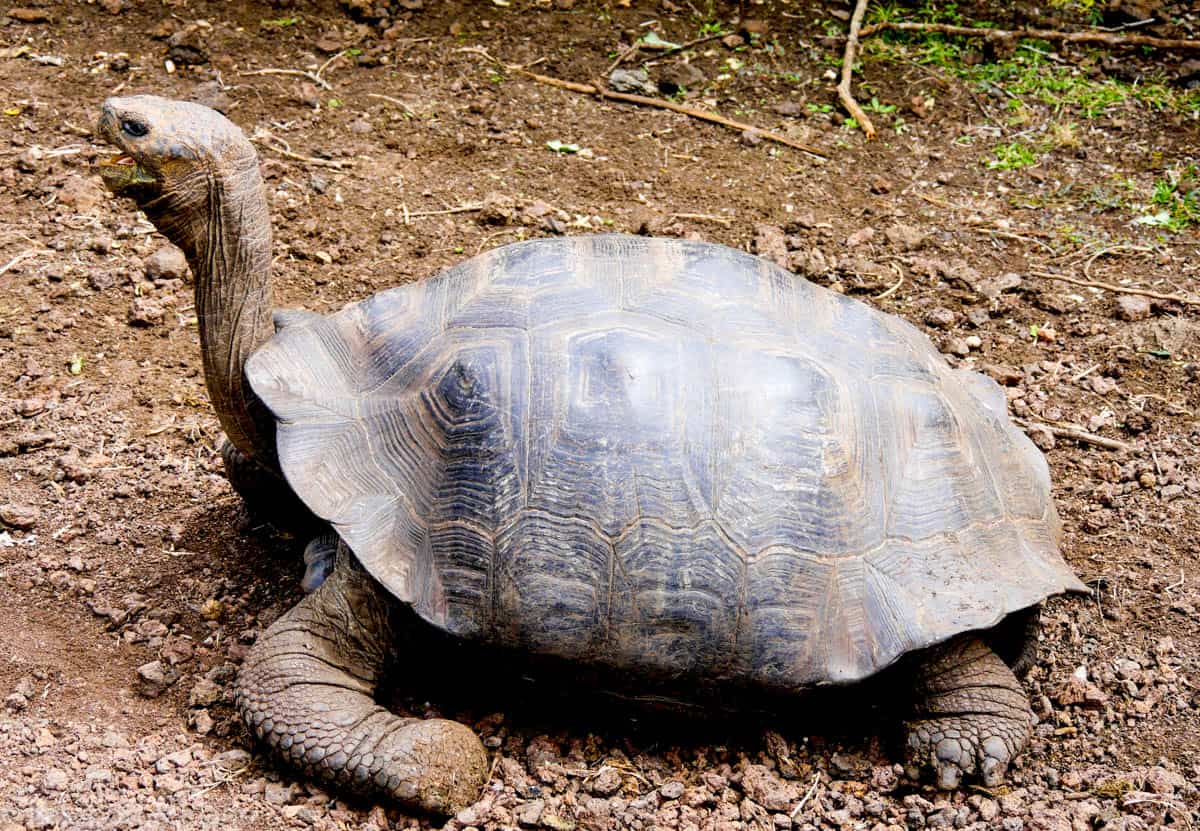
They’ll explain what the breeding centre does and how many tortoises they have. The animals are free to roam around so you can get up close to them. My favourite part though was the baby Galapagos tortoise pen. Hundreds of tiny tortoise which were so cute.
One of the most exciting facts that we learnt on our visit was the way that the researchers can change the sex of the eggs. They do this by raising the temperatures in the incubators.
It was also fascinating to learn how scientists had saved the DNA of a tortoise that became extinct in 2012 in the hope that they could recreate it through genealogy sometime in the future.
Entrance to La Galapaguera is free, and there’s ample parking for both cars and bikes.
El Junco Lagoon
As you head back to Puerto Baquerizo Moreno, a popular stop-off point is the El Junco Lagoon. Its quite a hike to get to the crater lake, but the views are worth the effort.
The crater is enormous and its the only source of freshwater in the Galapagos. It can be a little misty by the lake, and the view is not always clear, so don’t forget to take a rain poncho.
Look out for the mocking birds and frigates on the walk up to the crater; there’s a good chance you’ll see them preening their feathers by the freshwater.
Taxi hire is around $40 US for this half-day trip. You can hire bikes at many of the hotels or at cycle shops such as Cañon Point in town. Half a days rental will cost 10-15 Us Dollars.
Day 3 Full Day Tour
Diving at Kicker Rock or take an alternative day trip.
Kicker Rock or Leon Dormido as locals call it is the prominent rock formation that you can see off the coast of San Cristobal island. It rises almost 153 meters (500 feet) from the ocean and its one of the best places to go snorkelling or scuba diving.
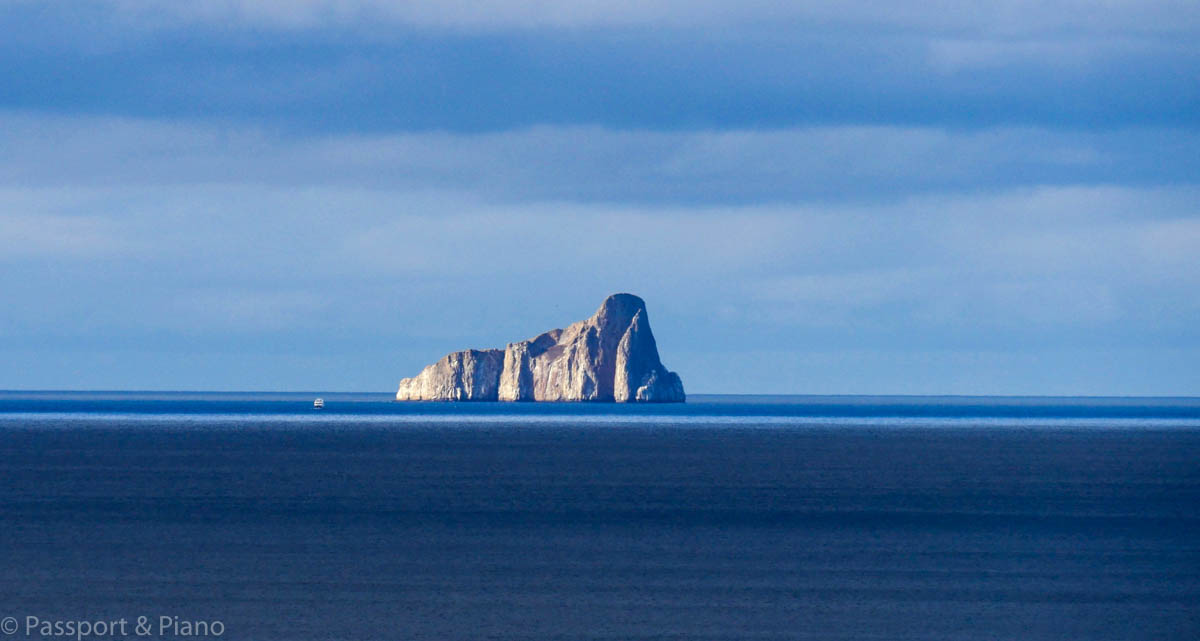
There’s an excellent chance that you’ll spot some sea turtles, rays, sharks and a plethora of tropical fish. Its also possible to see hammerhead sharks, especially if you go diving at Kicker Rock.
Aside from the magnificent underwater world, there’s an excellent chance that you’ll see some of the other animals from Galapagos islands. Sea lions are often basking in the sun along with the Galapagos marine iguanas.
You can often spot birds such as frigates, blue-footed and masked boobies on the cliffs as well.
Book your trip to Kicker Rock by clicking here.
Alternative day tours from San Cristobal Galapagos
If snorkelling so far away from the shore is not for you, book a day trip elsewhere. Below are a few suggestions.
Punta Pitt
Punta Pitt on the northeastern side of the island is one of the few places that you can spot Red Footed Boobies. In fact, on a day trip here, you are likely to see blue-footed boobies, Nazca boobies as well and frigate birds.
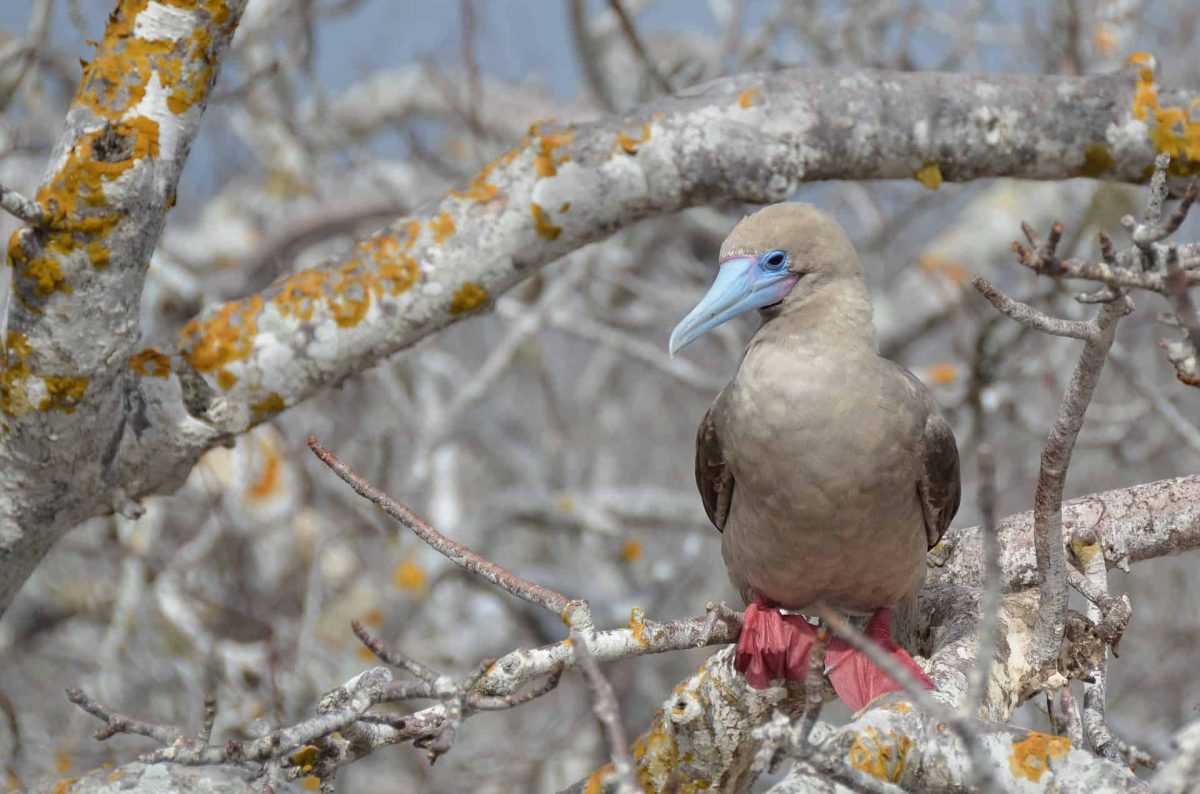
The volcanic rock that juts out is a popular nesting site for many birds on the Galapagos islands. Trips usually include some snorkelling as well, but this is generally off the shoreline at one of the beaches, and you don’t have to participate if you don’t wish.
Book a full-day tour to Punta Pitt by clicking here.
Visit Española Island
Española Island is one of the best Galapagos islands to visit between March and November as almost all of the world’s population of wild albatross come here to breed.
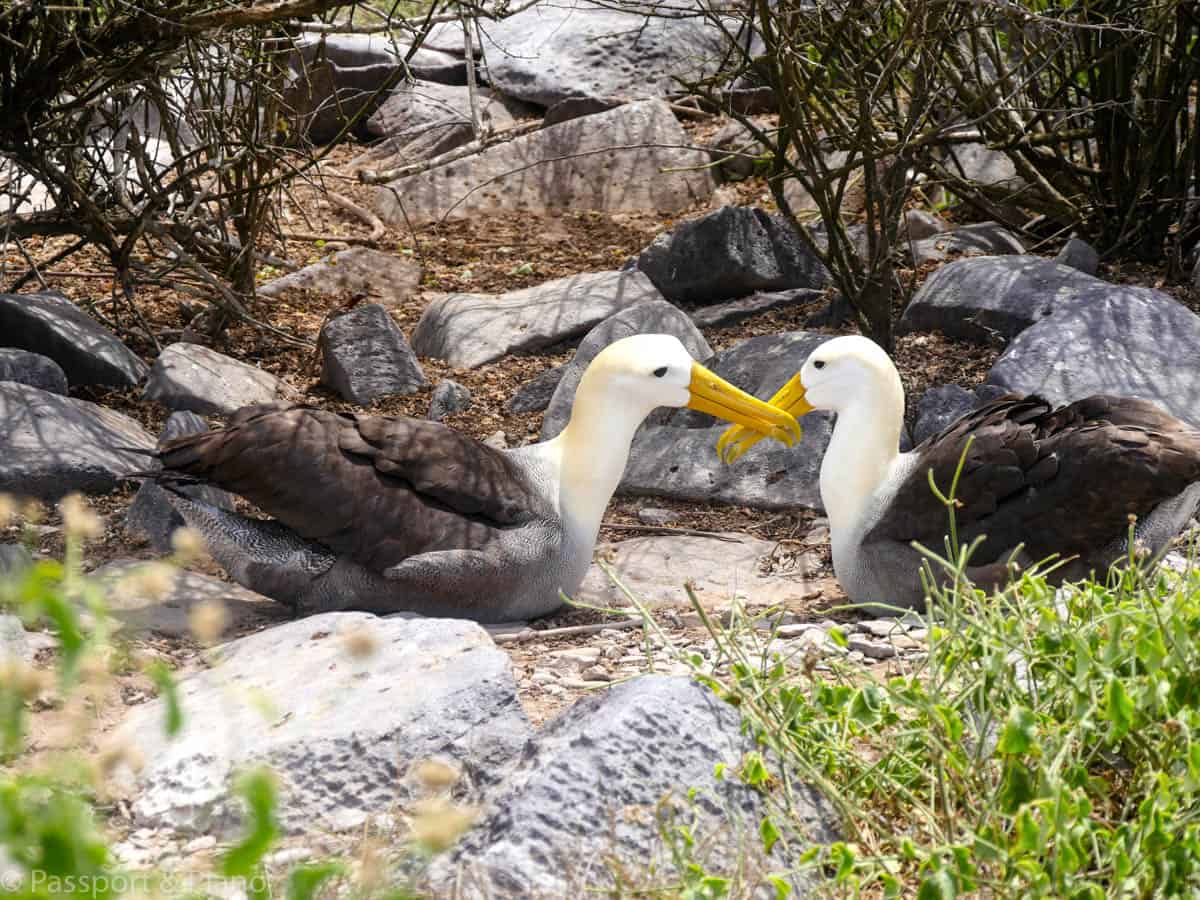
All species of the albatross are classed as vulnerable, but three are critically endangered. It’s a unique and moving experience to watch the adults with their babies, and it’s unbelievable how they don’t seem to mind if you get up close.
Blue-footed boobies also come here to breed at this time. Around the shoreline, you can easily spot sea lions and red iguanas.
You can book Galapagos day tours to Espagnola Island at this link.
Lobos Island
Lobos Island is much closer to San Cristobal than Española. It’s an excellent choice when planning land-based Galapagos tours, particularly if you’re not fond of long boat journeys.
PICTURE OF MARINE IGUANA
There’s plenty of snorkelling to enjoy off the beach, and of course, the sea lions will be there to keep you company. You can only visit the island as part of a tour, but it’s reasonably priced next to some Galapagos day trips.
As with many of the islands, there’s a good chance of spotting blue-footed boobies, and frigate birds who come here to nest. However, they’re not as prolific as on islands.
Learn more about a tour Galapagos islands Lobos trip here
Day 4 Morning transfer to Isabela Island
Transfer to Isabela Island either by speed boat or plane. I’d recommend flying with Emetebe.
For me, this scenic flight on a Britten-Norman BN-2 Islander lightweight aircraft was another fantastic experience on our Galapagos islands itinerary.
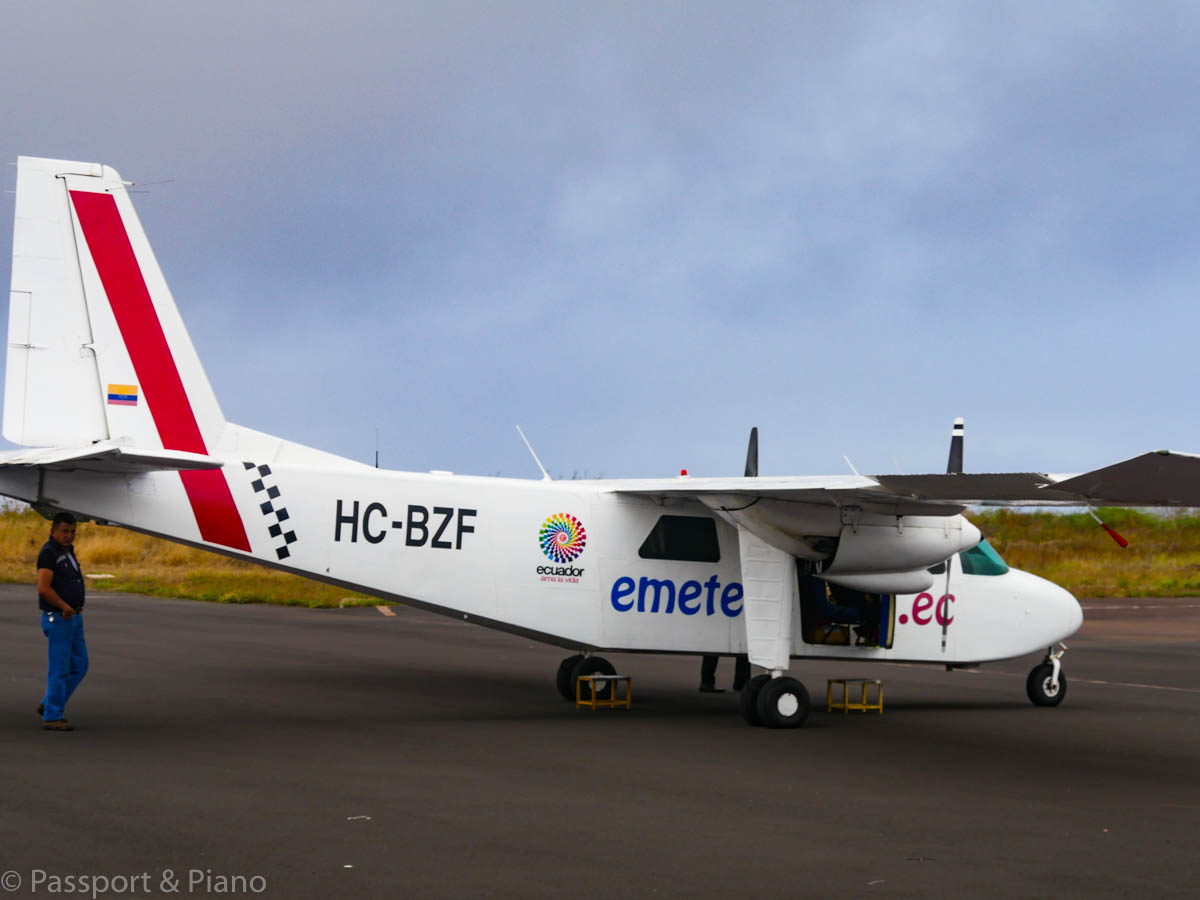
I sat next to the pilot in the cockpit, which was incredible. The view was amazing; we were literally in a white cloud. The flight only took 35 minutes, and as we descended, it was clear how different the island of Isabella was. It was like going across another planet, very black and volcanic.
The airport was the first building that we came to, and it fascinating to see how close we were flying to the ground before landing. The landing was good and not at all bumpy.
Once at a standstill, you get out onto the tarmac and grab your bag from the compartment below.
Isabela Island Galapagos
Isla Isabela is the largest of the Galapagos Islands, and it’s five volcanoes still show activity today. The main town Puerto Villamil, in my opinion, is much more charming than either Santa Cruz or San Cristobal.
You can learn more about things to do on Isabela Island by clicking here.
Puerto Villamil is small and has a laid back feel with sandy roads. It’s far less touristy than the other islands, so while there’s not as many hotels and restaurants, it feels more like paradise.
Where to stay on Isabela Island?
I highly recommend staying at Isabella beach house, which as the name suggests, is right on the beach. The harbour is only a 5-minute walk away, and the views are simply stunning.
Hot showers (not always guaranteed in the Galapagos), clean rooms, American breakfast and beautiful surroundings. What’s not to like?
The staff are friendly and dietary requests such as gluten-free can be catered for if necessary.
If you are gluten intolerant take a look at these fantastic travel cards by Jodi Ettenberg. They explain to restaurants in the relevant language what you can and can’t eat. They also give you the low down on what’s in local dishes.
You can hire bikes to explore and relax in the garden at the end of the day to watch the gorgeous sunsets.
If you prefer self-catering Sandy feet house is an excellent choice. It’s a home away from home.
It’s on the beach and just a few minutes from the shops. There’s a fully fitted kitchen, and there are laundry facilities if you need to wash some clothes.
There are books, DVD’s and board games to entertain you or the children and the terrace or garden is perfect for relaxing in. The property has wifi, and the host can help you organise transport from the airport if necessary.
Day 4 Afternoon
After you’ve settled into your accommodation, hire a bike or take a walk to the wall of tears. The wall is a historic site and while you might prioritise seeing animals on the Galapagos islands its well worth a visit.
If you’re walking, it will take around 2 hours to reach the wall from Puerto Villamil; hence hiring a bike is a good option. The path does have some inclines, but you can always push the bike in those sections.
It was along this path that we saw a Galapagos tortoise in the wild. While seeing them in the research centres is excellent, it is far more unusual to see a wild one.
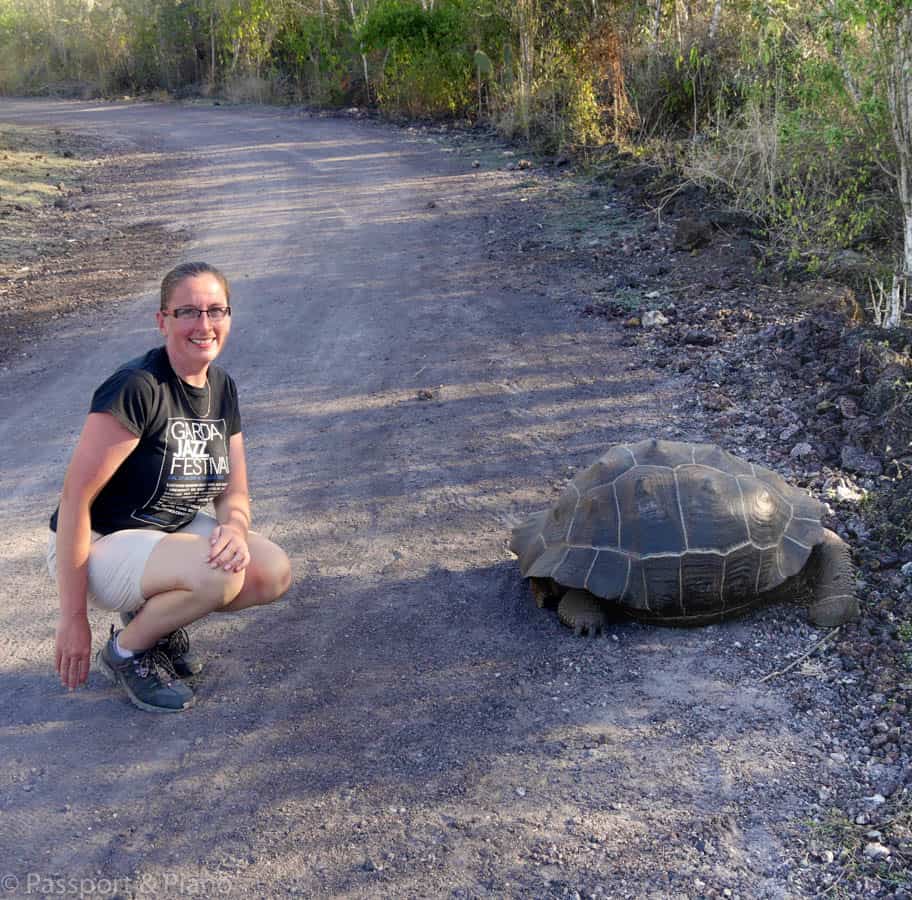
Visiting the wall of tears is one of the few land-based activities that does not require a national park guide, so it’s free. Prisoners who were sent here in the 1940s and 50’s built the wall by hand.
The only purpose of the wall was to make the inmates suffer. They had to carry the massive volcanic rocks from various places around the island to build the wall.
There were many injuries and even some deaths, which is why it called the wall of tears.
Day 5 -Tour to Sierra Negra Volcano
On a day tour to Sierra Negra, you’ll gain an insight into how the Galapagos islands evolved and see some dramatic scenery.
The hike is challenging at times, and you do require a certain level of fitness, but it’s well worth the effort. It takes around 30 minutes to get to the bottom of the volcano from town and the scenery on the way here changes dramatically from the sandy/ beach of the city, through to a more rainforest type environment.
The trees were particularly impressive, they reminded me of those in the enchanted wood stories or the flower fairies, with twisted branches and moss draping from them.
The hike begins at the base and its approximately 5km to the first crater and then a further 3 km walk to the smaller volcano chico.
You can book a tour through Viator here
Volcano Chico
The view across the crater is spectacular, even with the mist hanging overhead. As you continue onto Volcano Chico the climate changes and suddenly the lack of trees means there’s little protection from the burning sun.
The land is arid with only an occasional cactus jutting out from the ground. This section of the walk is one of the most challenging as the ground is unstable.
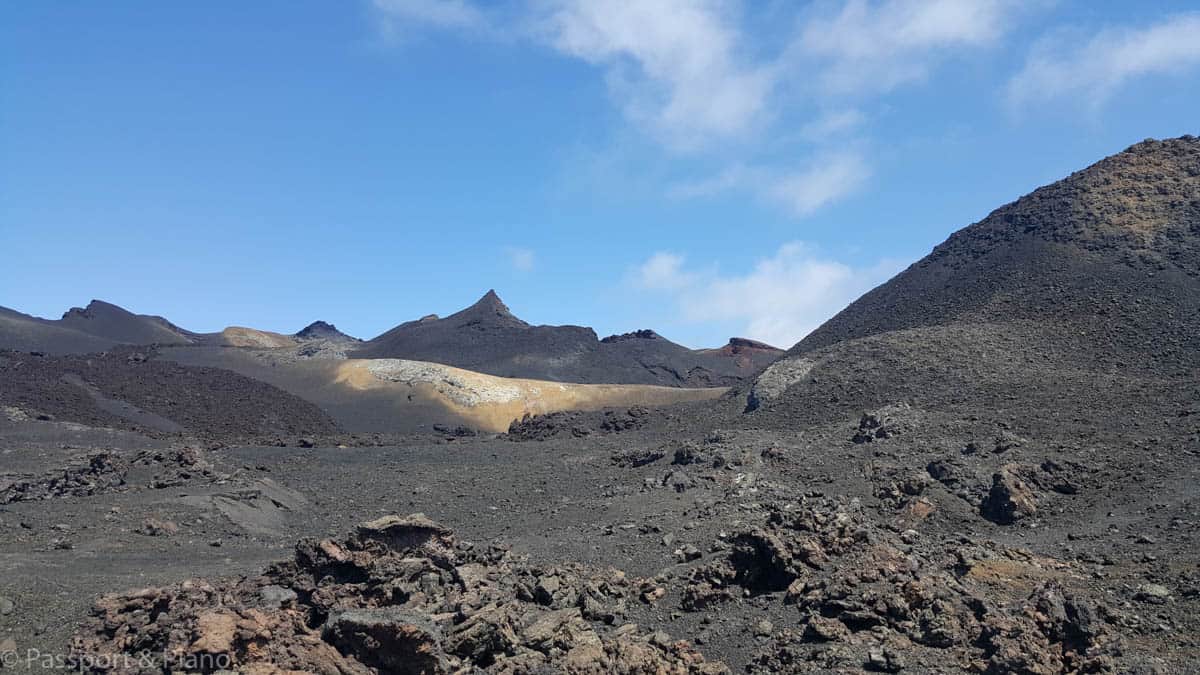
The mineral rock crumbles beneath your foot as you try and negotiate the path. The area is entirely baron, and you can see two distinct lava trails, one which is red from the eruption in 2005 and the other is completely black from the eruption in 1979.
On the black side, occasional ferns are beginning to grow. Yet, the landscape still feels baron and somewhat like your on another planet. There was one point where you could look into a small crater which was probably about 10 meters deep where the lava had spurted up from.
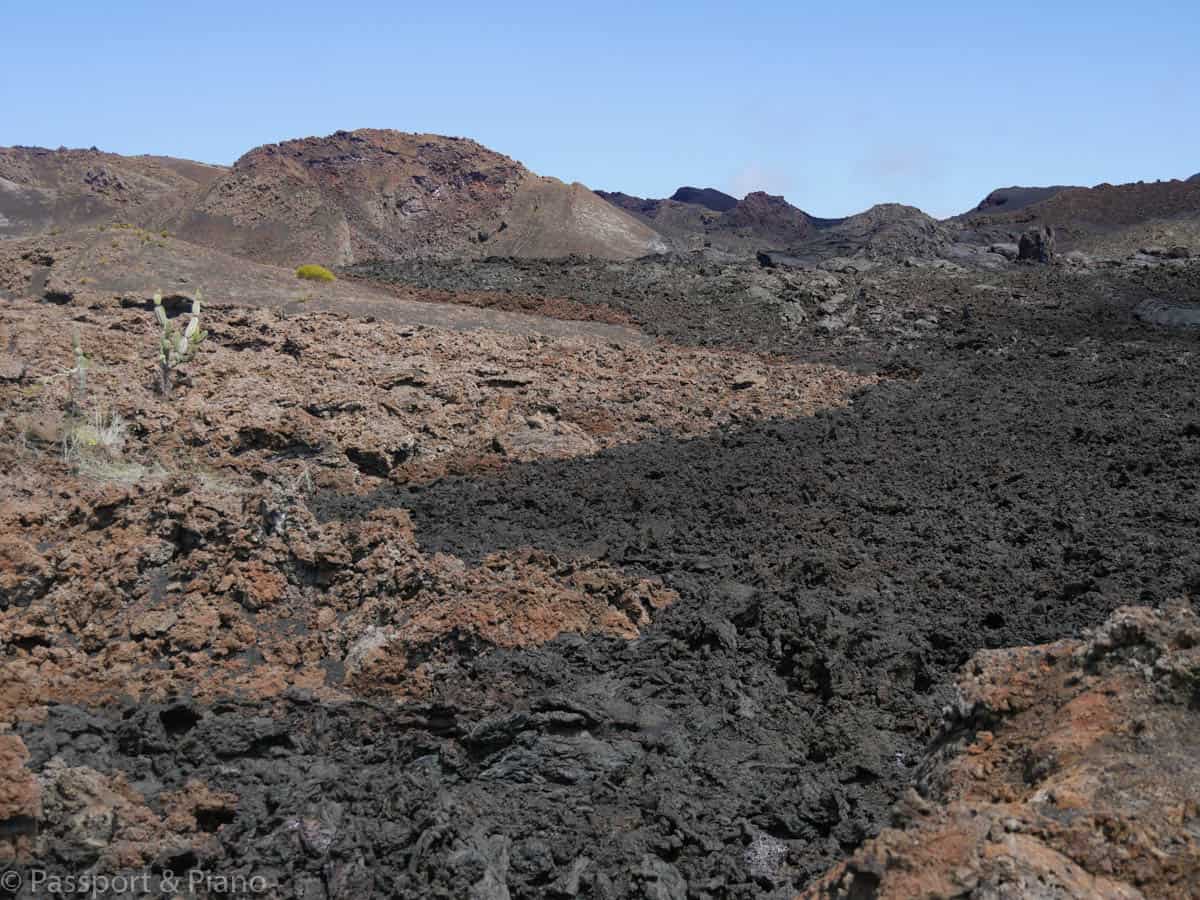
We were also able to put our hands into a small hole and sense the heat that was still coming out of the active chamber below.
There’s a final climb to reach the top, which is where you can have lunch while enjoying the magnificent view.
Of course, it’s a long walk back to the base, and although the hike is arduous at times, I would encourage everyone to do it. I’ve never experienced landscape like that anywhere else in the world.
On return to Puerto Villamil, I would suggest you spend the afternoon relaxing by the beach. If you have enough energy left, you could walk down to Concha de Perla and do a little snorkelling.
Book a tour to Sierra Negra through TripAdvisor here
Day 6 Morning Tour
Take a snorkelling trip to Los Tunneles.
A trip to Los tunneles is one of the Galapagos tours not to miss from Isabella Island. The lava formations that look like tunnels are in an uninhabited part of the island approximately an hour from Puerto Villamil.
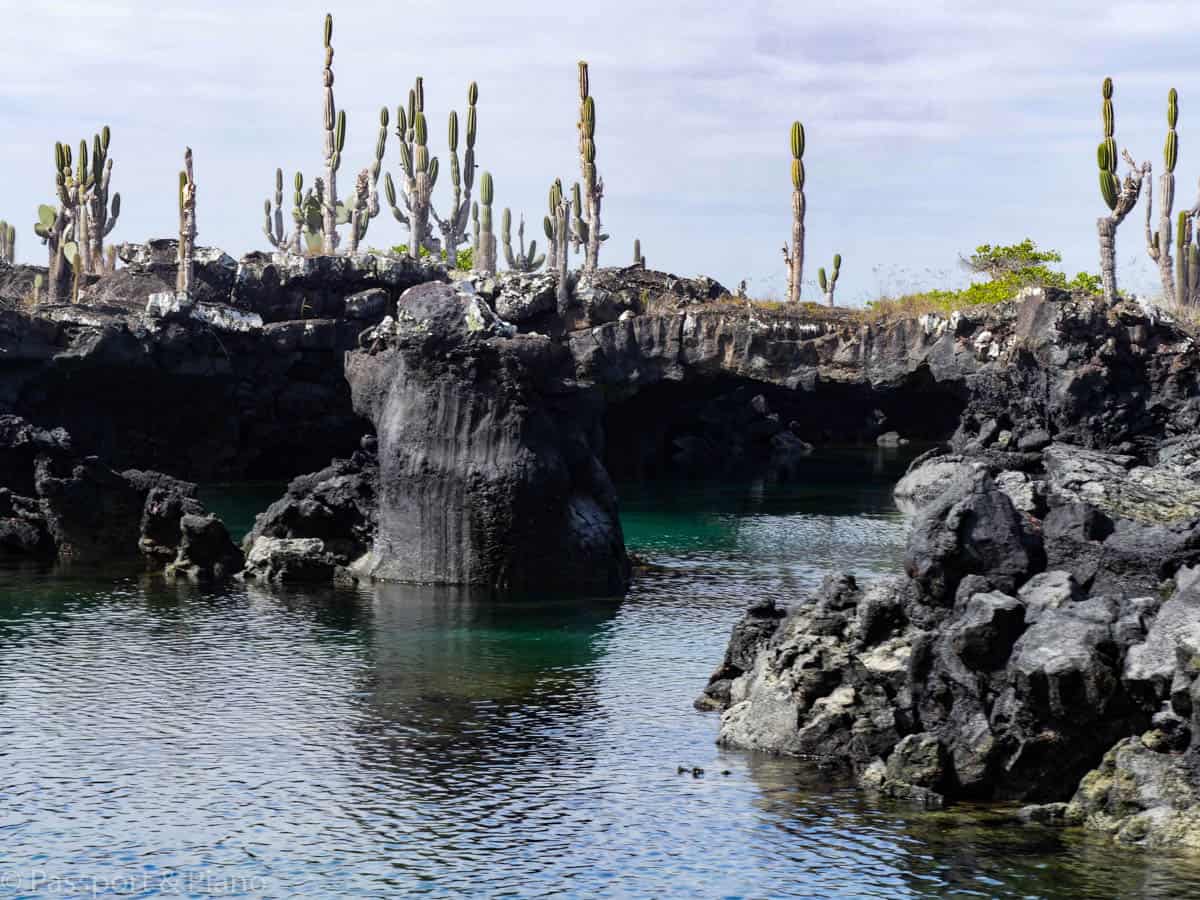
The area is so isolated that many animals from the Galapagos islands have made these waters their home. You can expect to see sea turtles, iguanas, sea lions, blue-footed boobies, frigate birds, manta rays, penguins, sea lions, a variety of birds, lobsters, and sea snakes.
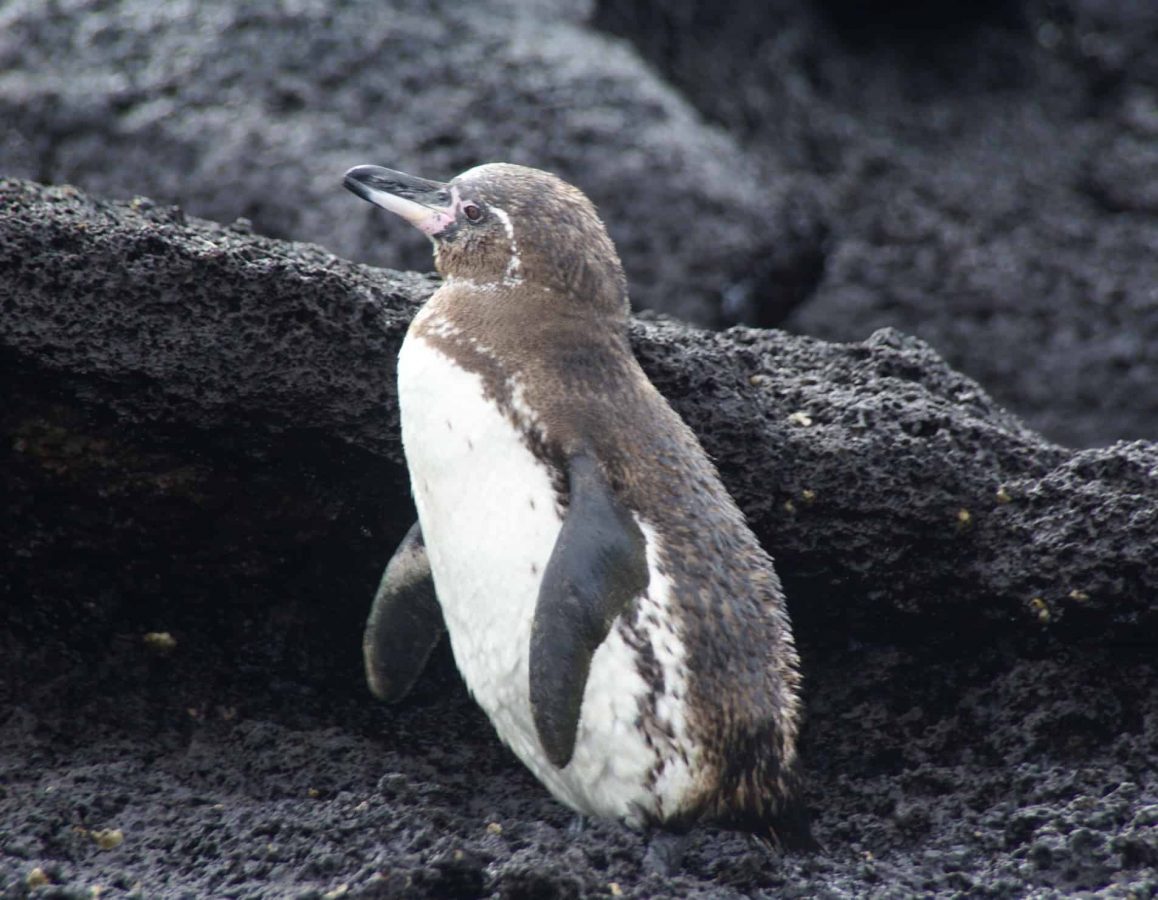
On route, you’ll stop at a few fantastic snorkelling spots. There’s a good chance of seeing white-tipped sharks, eagle rays, golden rays and a whole variety of fish including sea horses.
Los Tunneles
After some fantastic snorkelling, the boats make their way to Cabo Rosa, which is the name of the tunnels. As the boat slowly navigates through the lava formations, it feels like you’re entering Jurassic Park.
The landscape looks like it was made for a film set and its surreal to learn that the tunnels were formed thousands of years ago from volcanic activity. You’ll get the opportunity to take several short walks on the volcanic rock to explore and observe the landscape and wildlife.

The water beneath the tunnels is so clear and shallow that you can easily see the sea turtles and parrotfish swimming.
The blue-footed boobies were also basking in the sun alongside several iguanas. It was a truly spectacular experience.
Click here for more information on a day trip to Los Tunneles
Day 6 Afternoon
Take a walk to Pozo Salinas and the Tortoise Breeding Centre
Close to the main square, there’s a trail that leads to a lagoon called Pozo salinas. It’s a beautiful place to see flamingos and the wooden walkways make easy access and fantastic viewing.
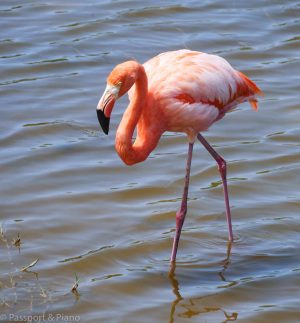
If you continue along the trail through the mangroves for a kilometre, you reach the tortoise breeding centre.
There’s a small museum which explains the breeding program, and you can see the endemic Galapagos tortoise in most stages of their life from tiny hatchlings through to breeding adults.
Day 7 Morning transfer to Santa Cruz Island
Take a boat to Puerto Ayora and transfer to Santa Cruz island.
Boats leave at 6 am and 2 pm from Isabella island to Puerto Ayora. To make the most of your day, I would suggest getting the early one. It’s easy to walk to the pier on Isabela, but you could get a taxi if you prefer.
On arrival, immigration will search your luggage and tag your bags. You then have to purchase a ferry token which costs a dollar before you’ll be allowed onto the pier.
A little water taxi takes you across to the leading boat, which is not that big, they can probably take 25 passengers. The bags are stacked inside by the crew, and you Chose a seat.
We sat right at the back people were cramming inside as you usually get wet from the crashing waves, but I had read that the boat is less bumpy at the back and of course you have constant fresh air.
As it turns out, we were fortunate, the sea was extremely calm, and the journey was both enjoyable and fast. On arrival at Puerto Ayora, you get another water taxi which costs 50 cents to take you to the pier.
Where to stay on Santa Cruz Island
Santa Cruz is the largest town and its home to some of the best Galapagos hotels. If you prefer 5-star accommodation, the Royal Palm Hotel Galapagos or the Angermeyer Waterfront Inn are excellent choices.
We stayed at the La K-Leta Boutique Guesthouse, which I can highly recommend. It doesn’t have a pool; hence it’s not five stars, but it has everything you could wish for in a place to stay.
The gardens are beautiful, and there’s a lovely reading room to relax in the evening. Every morning, they’ll serve you a delicious breakfast in your room, and you can choose from the menu the night before.
The staff are super attentive and will help you arrange transport to and from the airport if needed. The rooms have a fridge and a kettle for your convenience.
There’s also a large water decanter, so you don’t need to worry about buying bottles of plastic drinking water.
The property is within a short walking distance of the town centre, and there are several excellent restaurants close nearby.
Day 7 Afternoon
Tortuga Bay
Having had an early start once you’ve settled into your hotel, take a walk to Tortuga bay and relax at this idyllic beach. From town, it takes around 30-40 minutes along the trail path to reach the white sandy beach Playa Brava.
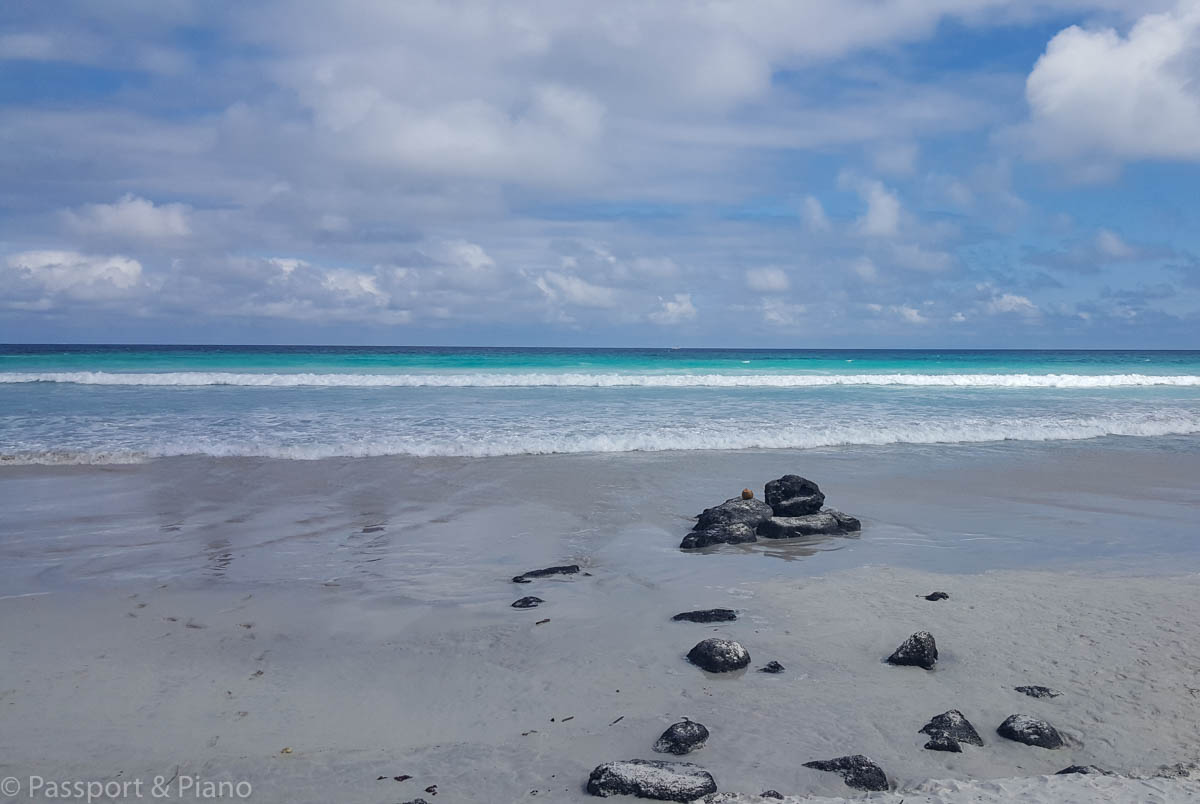
If you prefer you can take a water taxi to get there, however, I’d recommend walking as the scenery is beautiful along the way.
Amongst the cacti and plants that line the path, you’ll see numerous birds of the Galapagos Islands such as mockingbirds and yellow warblers.
Lookout on the trail for lava lizards and iguanas basking in the sun.
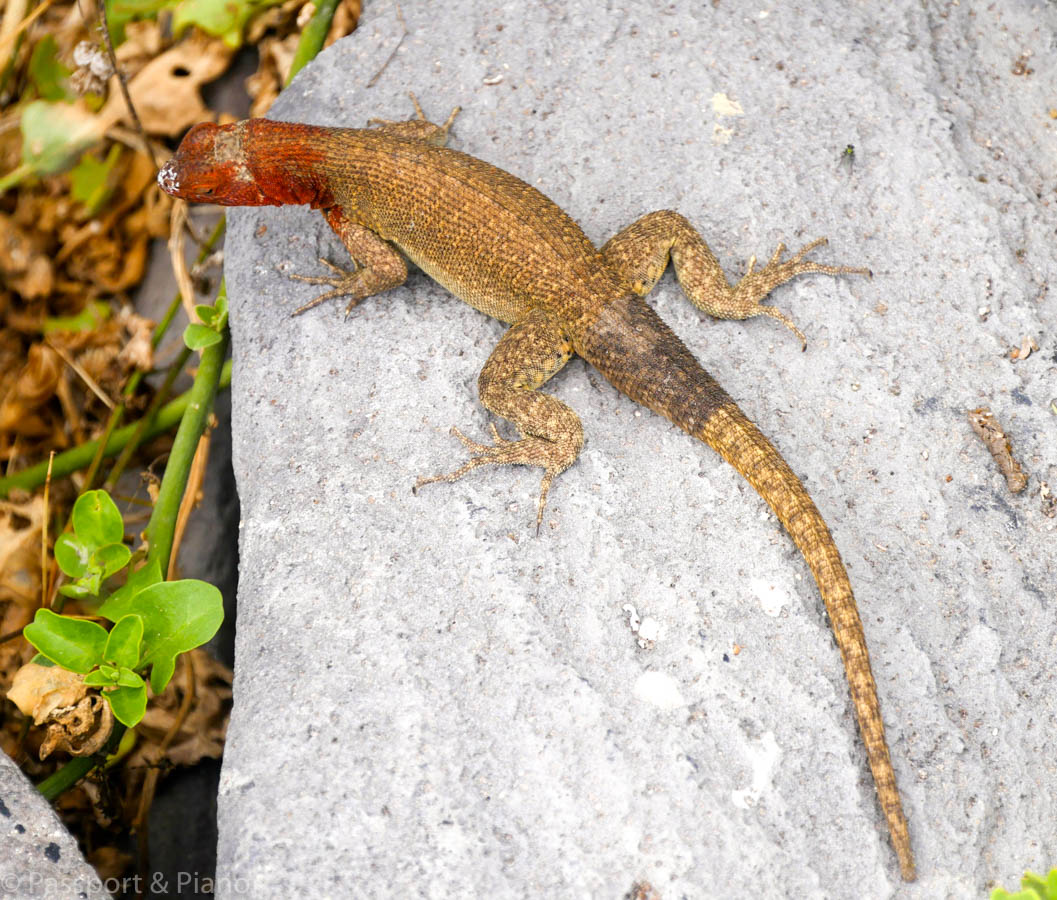
The beach Playa Brava is stunning, but swimming is prohibited here due to the strong currents. Have a rest and soak up the vistas before continuing to Playa Mansa.
Playa Mansa
If you walk to the right along playa brava you’ll see a path through the mangroves, this leads to playa Mansa. Here the waters are much calmer, and the snorkelling is fantastic.
The mangroves are home to white-tipped reef sharks, sea turtles and an array of fish. Don’t forget to take your snorkelling gear with you, a dry bag and of course your underwater camera.
Want to know more about things to do in Santa Cruz, this post has all the information you need.
Day 8 Full Day Tour
Take a North Seymour Galapagos islands tour.
North Seymour Island was my favourite trip on our Galapagos vacation. The boat was more substantial than most, and unlike many of the other Galapagos islands tours by boat, we’d taken it travelled at pleasant speed.
It takes around 50 minutes to reach the island, and it’s by far the best place to see the magnificent frigate birds during the breeding season. The guide takes you on a tour of the island, and you’ll learn lots about flora and fauna.
Many of the animals on Galapagos islands are the same; however, on North Seymour, there’s a good chance of sighting a Galapagos Land Iguana as well as boobies, and frigate birds.
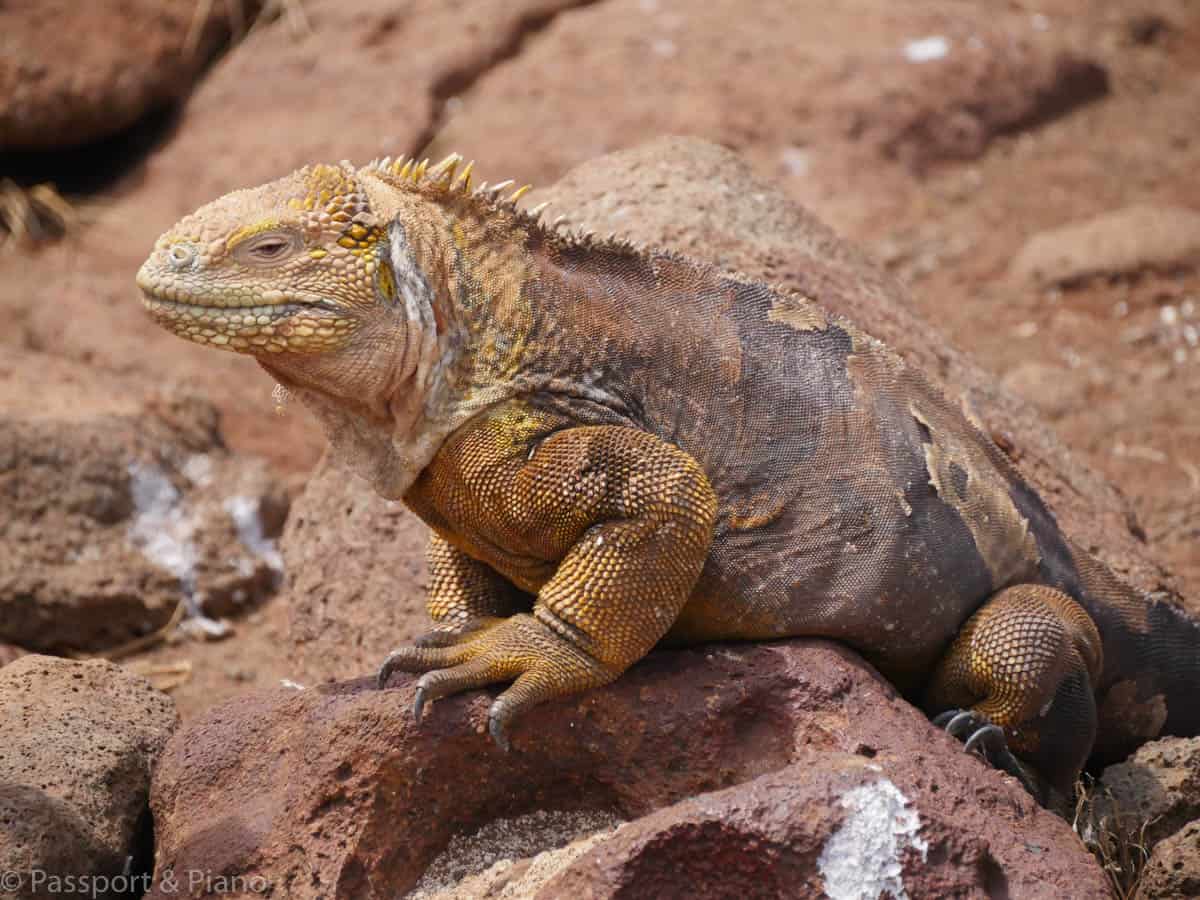
Land iguanas are different from the marine ones that you see virtually everywhere in that they’re green/yellow and slightly more prominent. As we continued, there were lots of frigate birds nesting and loads of chicks to see at various stages of growth.
We were lucky enough to see many examples of the male frigate bird doing his mating display, in which he inflates his red pouch and spreads his wings. Their wingspan is huge, around, 150 metres.

We also saw lots of blue-footed boobies with there babies, again they varied in age between 4-12 weeks.
Book a trip to North Seymour Island through TripAdvisor here.
Mosquera Island
After lunch on board the boat you head to a small island beach named Mosquera, which was stunning just like a desert island, we were the only ones there.
Here there’s the opportunity to go snorkelling off the shore, and the crystal clear water makes for excellent visibility. I also had the pleasure of a group of sea lions for the company.
They were such fun and just wanted to play. At first, its a little daunting when they chase you, but once you realise they want to play its an excellent experience.
Day 9 Morning
Head to the Charles Darwin Research centre
Over 200 scientists, researchers and volunteers work at the Charles Darwin Centre, and they regularly work to preserve the Galapagos islands animals.
On a visit here you can see many of the 11 remaining giant Galapagos land tortoises and learn some interesting facts about the islands. One of the most popular exhibits is Lonesome George.
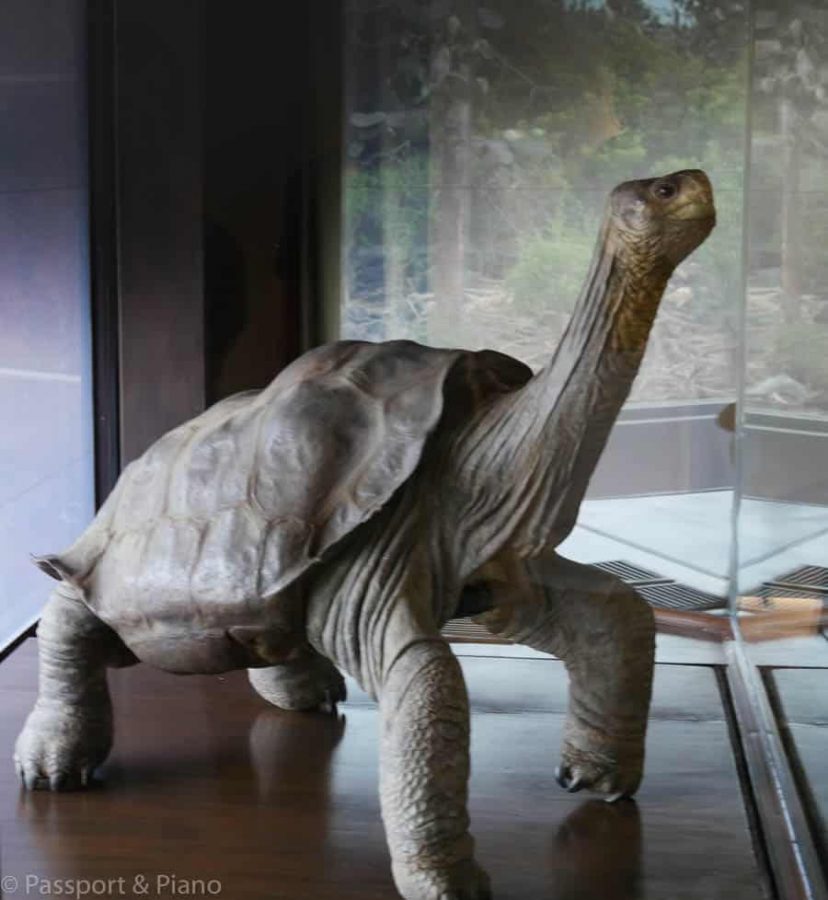
He was the last surviving species of the tortoise breed Chelonoidis Abingdon. Sadly the scientist’s efforts to conserve the species failed, but his body has been embalmed.
It’s on display in a separate room along the tortoise walkway. He is enormous, and its thought that he died between the age of 80 and 100.
At the end of the tour, there are a few other exciting exhibits, including some whale bones and the evolution theories of Charles Darwin. The gift shop is well worth a look, and you can get your passport stamped at the counter for a fee.
Do note that it is illegal too but such stamps in your passport, but I’ve never had an issue. I’ve got several souvenir stamps from Machu Picchu and Easter Island as well as the Galapagos.
Head back to town for lunch and a short stroll around Laguna de la ninfas
Laguna de la ninfas
Laguna de las ninfas is a lagoon just a few blocks back from the main pier. Its a peaceful place and the boardwalks make it easy to walk around the beautiful turquoise water.
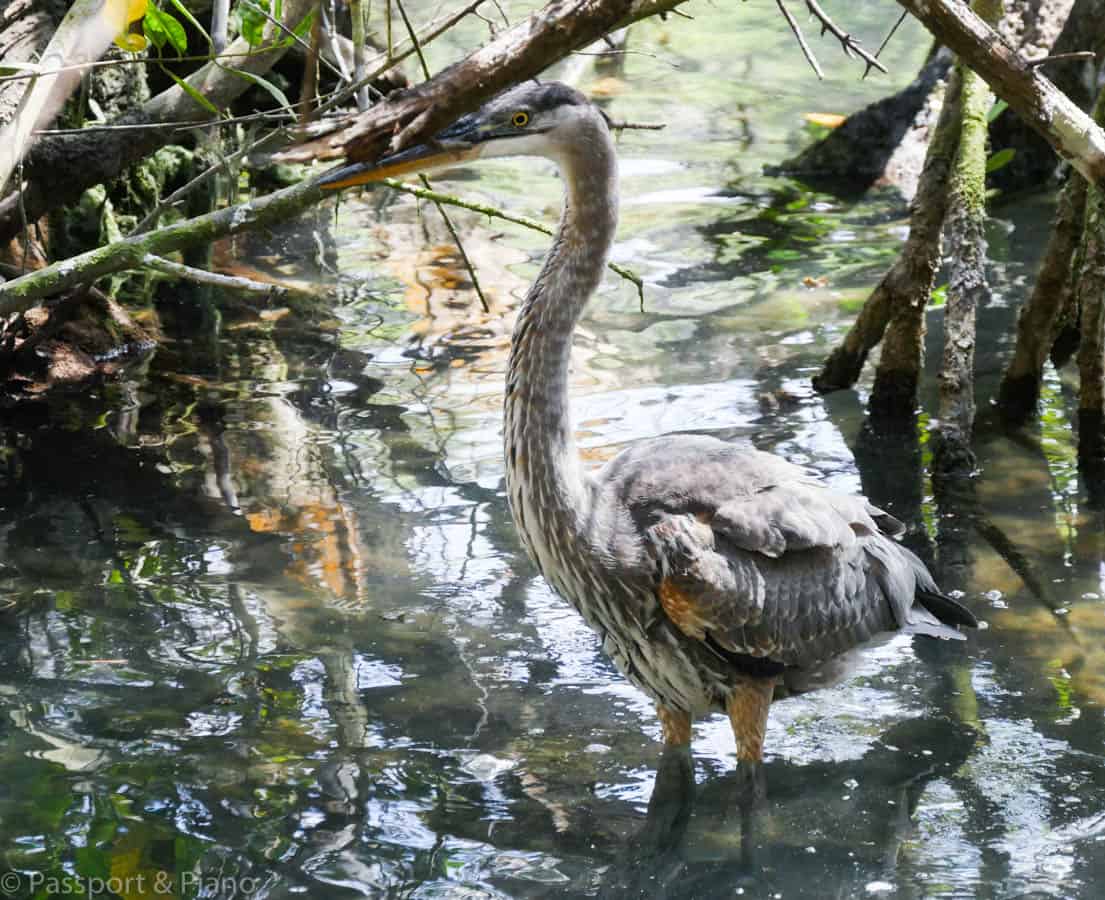
It’s a great place to relax and read a book. If you’re lucky, you’ll spot some birds like the magnificent blue heron that we saw above.
Day 9 Afternoon
Take a trip to Los Gemelos, in the highlands.
From Puerto Ayora its easy enough to get a taxi to the twin craters of Los Gremlos, but you could also book a tour if you prefer.
The climate in the highlands is much colder due to the surrounding forests and its a great place to spot Charles Darwin finches and short-eared owls.
The craters are sinkholes which form when the volcanic roof of an empty magma chamber collapses.
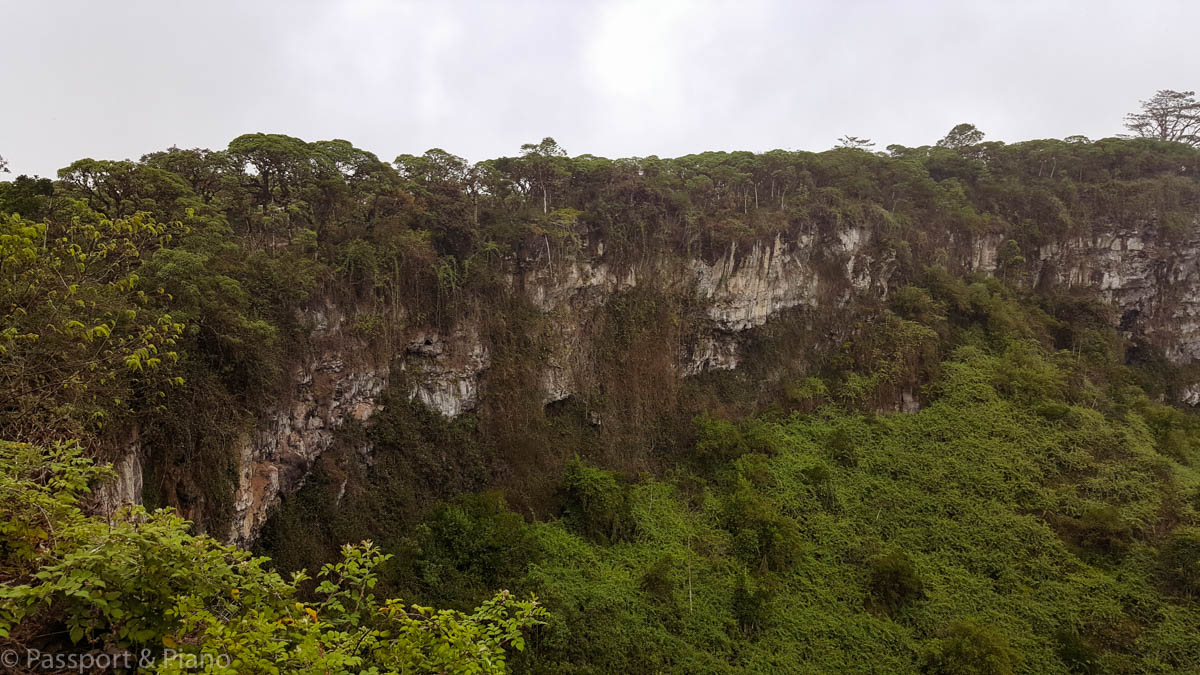
There’s a trail that you can follow around the edge of the craters where you can often spot Vermilion flycatchers.
Your taxi driver will wait if you ask them to and then you can get them to take you to el Chato on the way back.
El Chato
El Chato is a nature reserve and one of the few places that you can see Giant Galapagos land tortoise in the wild. You could also incorporate a visit to the lava tunnels which you can explore.
Inside you can see the different layers of strata although you will need a torch as its pretty dark.
Day 10
Sadly its time to depart the Galapagos islands and head back to Equador. Before your flight spend a little time shopping around town and head to the pier to catch a last glimpse at the spectacular marine life. On several occasions, we saw small sharks and rays here.
To get to Baltra Airport leave yourself plenty of time as you will need to catch the ferry and a bus.
From your hotel, get a taxi to take you to the Itabaca Channel, which costs around $25.
From here you can get the ferry across which costs a couple of dollars.
On the other side of the channel, you can board the airport bus which runs regularly. It cost $5, and the bus ride is only 10 minutes.
Extend your stay with a few days at Floreana Galapagos Island
The fourth island that you can stay on is Floreana. It’s less frequently visited by tourists and the islands only Puerto Velasco Ibarra is the perfect place to end your Galapagos island tour.
Floreana is peaceful, and a stay here is like stepping back in time. The snorkeling around the island is exceptional and it’s fantastic to watch the wildlife without hoards of tourists around.
The best place to stay on the island is the Black Beach House. Ingrid the owner will arrange your ferry transfers for you and help you plan your stay.
There are few restaurants and shops on the island so it’s worth bringing some provisions from Puerto Ayora with you.
Summary
Galapagos island vacations are not cheap whether you take a cruise or land-based Galapagos tours. However, its an unforgettable experience and by planning your itinerary you can make sure you get the best Galapagos tour for your budget.
To make further savings to this Galapagos itinerary 10 days, you could substitute the hotels for hostels.
Backpacking Galapagos islands is possible, and if you have more time, you can get some of the best Galapagos tours last minute at a fraction of the price.
Passport and Piano is a participant in the Amazon Services LLC Associates Program, an affiliate advertising program designed to provide a means for sites to earn advertising fees by advertising and linking to amazon.com, amazon.co.uk, amazon.ca. Amazon and the Amazon logo are trademarks of Amazon.com, Inc. or its affiliates.





